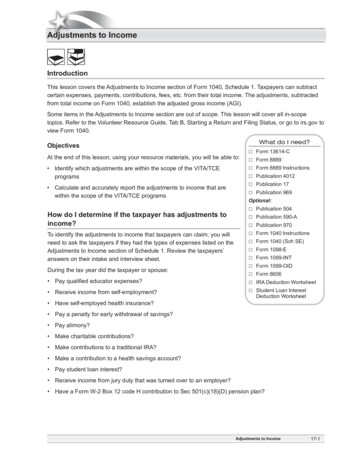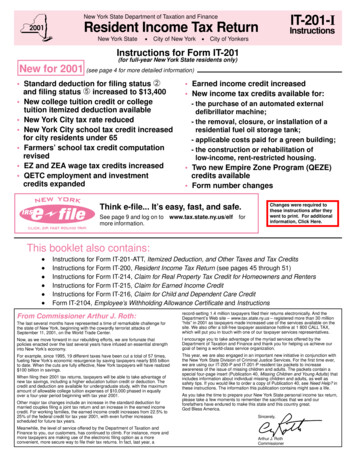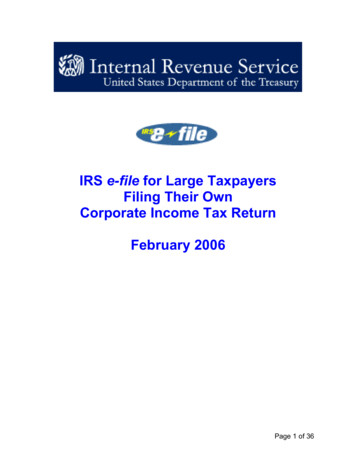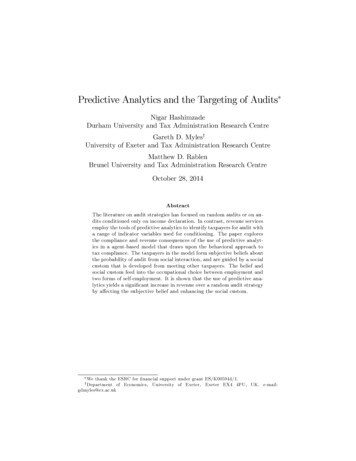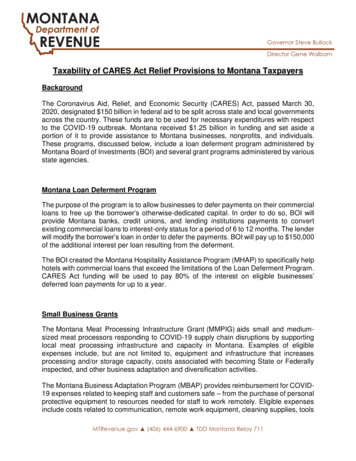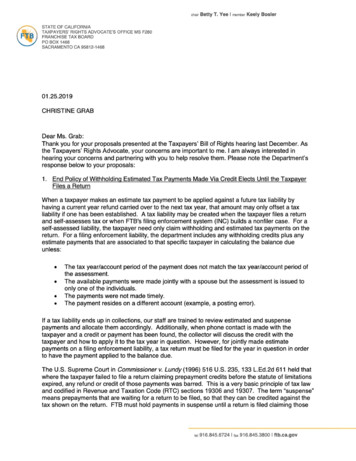
Transcription
chair Betty T. Yee member Keely BoslerSTATE OF CALIFORNIA TAXPAYERS' RIGHTS ADVOCA TE'S OFFICE MS F280 FRANCHISE TAX BOARD PO B OX 1468 SACRAMENTO CA 95812-146801.25.2019 CHRISTINE GRABDear Ms. Grab: Thank you for your proposals presented at the Taxpayers' Bill of Rights heari ng last December. As the Taxpayers' Rights Advocate, your concerns are important to me. Iam always interested in hearing your concerns and partnering with you to help resolve them . Please note the Department's response below to your proposals:1. End Policy of Withholding Estimated Tax Payments Made Via Credit Elects Until the Taxpayer Files a ReturnWhen a taxpayer makes an estimate tax payment to be applied against a future tax liabilityby having a current year refund carried over to the next tax year, that amount may only offs et a tax liability if one has been established. A tax liability may be created when the taxpayerfiles a return and self-assesses tax or when FTB's filing enforcement system (INC) builds a no nfiler case. For a self-assessed liability, the taxpayer need only claim withholding and estima ted tax payments on the return. For a filing enforcement liability, the department includes an y withholding credits plus any estimate payments that are associated to that specific taxpay er in calculating the balance due unless:The tax year/account period of the payment does not match the tax year/account period of the assessment.The available payments were made jointly with a spouse but the assessment is issued to onl y one of the individuals.The payments were not made timely.The payment resides on a different account (example, a posting error).If a tax liability ends up in collections, our staff are trained to review estimated and suspensepayments and allocate them accordingly. Additionally, when phone contact is made with thetaxpayer and a credit or payment has been found, the collector will discuss the credit with th e taxpayer and how to apply it to the tax year in question. However, for jointly made estima te payments on a filing enforcement liability, a tax return must be filed for the year in questi on in order to have the payment applied to the balance due.The U.S. Supreme Court in Commissioner v. Lundy (1996) 516 U.S. 235, 133 L.Ed.2d 611 hel d that where the taxpayer failed to file a return claiming prepayment credits before the statu te of limitations expired, any refund or credit of those payments was barred. This is a very ba sic principle of tax law and codified in Revenue and Taxation Code (RTC) sections 19306 and19307. The term "suspense" means prepayments that are waiting for a return to be filed, sothat they can be credited against the tax shown on the return. FTB must hold payments in su spense until a return is filed claiming thosetel 916.845.6724 fax 916.845.3800 ftb.ca.gov
01.25.2019 Taxpayers' Bill of Rights Hearing Responses Page 2credits. See TAM 2005-5 and authority cited. https://www.ftb.ca.gov/law/Tec hnical Advice Memorandums/2005/20050005.pdf2. End Policy of Withholding Estimated Tax Payments Made by Married CouplesGenerally, when taxpayers make joint estimated payments or have an overpayment on a join t return, the estimated payment and/or overpayment are considered as being made by both t axpayers for the joint tax liability. Pursuant to RTC section 19301(a), the amount of the overp ayment may be credited against the amount due from both taxpayers and the balance shall b e refunded to both taxpayers. As stated above, in order for FTB to refund the overpayment an d/or an estimated payment, a joint return would need to be filed for FTB to determine the ent ire tax amount due had been satisfied for that year.In the situation where the taxpayers make joint estimated payments or have a joint overpaym ent and subsequently file separate returns, California law is similar to federal law. Under feder al law, the taxpayers can apportion the joint estimated tax payments between them in any m anner the taxpayers agree on. (Treas. Reg. § 1.6654-2(e)(5)(ii)(A).) If the spouses can't agreeupon an allocation, there are rules in the Treasury Regulations on how to apply the joint estim ated tax payments to the spouses' separate liabilities. (Treas. Reg. § 1.6654-2(e)(5)(ii)(B).) Sim ilarly, when FTB issues separate assessments to married taxpayers that go final and are due a nd payable, FTB cannot allocate the joint estimated tax payments or overpayment to the taxp ayers' separate liabilities without a return in which the taxpayers have apportioned their jointoverpayment and/or estimated tax payment.3. Disclose Taxpayers' Rights Hearing to General PublicRTC section 21006 provides for an annual hearing before the Board where industry represen tatives and individual taxpayers are allowed to present their proposals on law changes. Thisis a public meeting held annually in December at the Franchise Tax Board and subject to theBagley-Keene Open Meeting Act. Taxpayers are not required to submit anything in advanceof the meeting to access their rights, they only need appear and present their issues.The Department would disagree with the statement that FTB goes to great lengths to hide th e Taxpayer Bill of Rights hearing from the general public. In fact, our Education and Outreachprogram covers the Taxpayer Bill of Rights hearing at many of our tax professional events. R epresenting approximately 65% of returns filed, tax professionals often have a clear understa nding of FTB policies and procedures from working with us on multiple accounts and issues a nd have a vested interest in seeing things change for the better. Tax professionals representall segments of the populations, including those with lower incomes. Tax professionals in ma ny cases are our partners in helping taxpayers file accurately, timely, and pay the correct am ount of tax, reducing taxpayer burden.To ensure the general public is aware of the Taxpayer Bill of Rights Hearing, FTB follows theBagley Keene Open Meeting Act which requires that we publicly notice this meeting, prepar e agendas, accept public testimony and conduct the meeting in public. The required 10-daypublic notice of the meeting and the agenda is on our website. As the result of your letter la st year, we also placed a link to the meeting notice on our home page during the 10-day pe riod preceding the hearing.
01.25.2019 Taxpayers' Bill of Rights Hearing Respo nses Page 3Additionally, I would like to clarify that FTB does not send out the 4058 or 4058C. Instead th ey are referenced in our bills and collection notices as publications on our website which co ntain information about taxpayer rights. We will consider your recommended changes to the4058 and 4058C during the annual review of all publications.4. Move the Taxpayers' Rights Advocate's Office to Government OperationsThe job of the Taxpayers' Rights Advocate is a complex one. The position by law reports dir ectly to the Executive Officer to ensure independence from the other divisions of the depart ment. It is important that the Advocate is an expert in the needs of the taxpayer and the ta x practitioner community, and the clear voice of reason in resolving disputes between taxp ayers and the Franchise Tax Board. Having the position at FTB ensures that conversations a re had, collaboration occurs, and that the rights and concerns of taxpayers are considered a long with revenue and resource constraints when developing FTB policy or tax administration decisions.Each of the tax agencies, BOE, CDTFA and FTB have Taxpayer Advocates established by sta tute. Your proposal would not only require an amendment to RTC section 21001 but also cha nges to provide the authority and/or resources to each of the agencies involved. Should you r State Representatives introduce legislation, we will work with them.5. Tax Appeals Assistance ProgramAlthough the Office of Tax Appeals was established to hear appeals from California taxpayersregarding various taxes and fees administered by the CDTFA and the FTB, the Office of Tax A ppeals was not provided the authority or resources to administer the TAAP program. In additi on, the OTA has determined that running a TAAP program would constitute a conflict of intere st for that agency.When the BOE was restructured into the CDTFA and the OTA, FTB felt that it was important th at this vital program for taxpayers be continued. If FTB had not taken it, this would have end ed the program for franchise and income tax appeals. The TAAP program at FTB will be underthe Taxpayers' Rights Advocate Office, independent of other areas of the department. UnderTAAP, law students assist taxpayers during the appeal process and do not answer to FTB's Ex ecutive Officer or Governance Council.6. Acknowledgement of Abatement Request and Disclosure of Taxpayers' Rights in the Abatement ProcessForms and correspondence including FTB 2917 and FTB 2924 (reasonable cause-claim for ref und) submitted by taxpayers or their representative's as a MyFTB Message through the taxp ayer's account are viewable as received by FTB on the taxpayer's MyFTB account. Requestsreceived through general correspondence are generally viewable in MyFTB within 30 days ofreceipt. FTB does not send an acknowledgement through the mail for incoming corresponde nce received by FTB.Correspondence, including claims for refund, is typically processed within 30 calendar daysof receipt by FTB. Approximately 90% of the reasonable cause requests are fully resolved w ithin the 30 calendar day timeframe. The remaining requests are referred to either Audit orAccounts Receivable
01.25.2019 Taxpayers' Bill of Rights Hearing Re sponses Page 4Management for analysis and determination. Timeframe for resolution may vary dependin g on the circumstances of each case.Where FTB fails to respond to the claim within six months, RTC 19331 allows the taxpayer t o consider the claim disallowed and file an appeal of the "deemed denial" with the Office ofTax Appeals. In reviewing our publications and our claim for refund webpage, there wasn't i nformation addressing a "deemed denial". As a result, we can look into adding this languag e on the website and in a subsequent edit of the publication.As for TAAP representation, those offers are extended after the taxpayer has filed an appea l and we've determined the taxpayer doesn't have a representative, the issue and dollar a mount of the appeal meet our criteria, and that we have enough student resources to assign the case.7. Provide Legal Codes that Justify Assessing Tax Liability to People who Hold Licenses.RTC section 19087 provides the FTB with the authority to propose an assessment from anyavailable information which indicates that the taxpayer, who fails to file a tax return, has afiling requirement for a particular tax year. Furthermore, the Board of Equalization has heldthat the FTB has great latitude in estimating income when a return has not been filed by ataxpayer, including using third-party information to estimate income. (Appeal of Walter R.Bailey, 92-SBE-001, Feb. 20, 1992; Appeal of R. and Sonja J. Tonsberg, 85-SBE-034, Apr 9, 1 985) As such, RTC section 19087 allows the FTB to use third party information, such as occ upational licenses, to estimate a taxpayer's income.8. Establish Clear Guidelines as to what Constitutes an Abatement RequestBased on your question, we are inferring that your reference to "Abatement Requests" re fers to the Claim for Refund procedures and process pursuant to RTC sections 19301 through 19368.On the FTB's website, the FTB has a webpage entitled "Claim for Refund" which provides inf ormation to taxpayer regarding their rights and responsibilities in submitting a claim for refund.Furthermore, when a claim for refund is denied, the FTB provides a publication (FTB 1084 - Ind ividuals and FTB 1087 - Business Entities) which explains a taxpayer's right to appeal the deni al of the claim for refund and the required timeline to file the appeal. In both publications, FTB1084 and FTB 1087, taxpayers are invited to provide any new information or additional inform ation to the FTB within ninety (90) days for the FTB to reconsider the denial of the claim for re fund. Therefore, a taxpayer is always welcome to submit additional information within the 90day appeal window after a denial and the FTB will review and consider the additional information in its review.Sincerely,Susan Maples Taxpayers' RightsAdvocate
01.25.2019 Taxpayers' Bill of Rights HearingResponses Page 5cc: Yvette M. Stowers Jacqueline Wong- Hernandez Irena Asmundson Val Davidson
4. Move the Taxpayers' Rights Advocate's Office to Government Operations The job of the Taxpayers' Rights Advocate is a complex one. The position by law reports dir ectly to the Executive Officer to ensure independence from the other divisions of the depart ment. It is important that the Advocate is an expert in the needs of the taxpayer .
